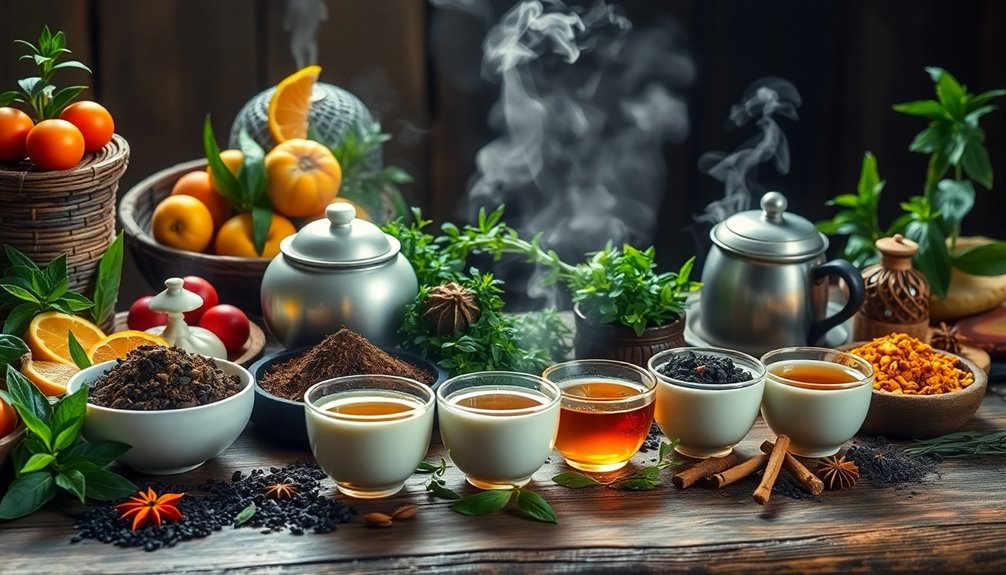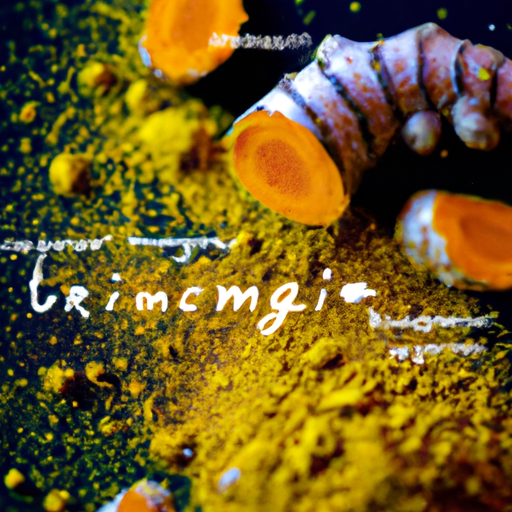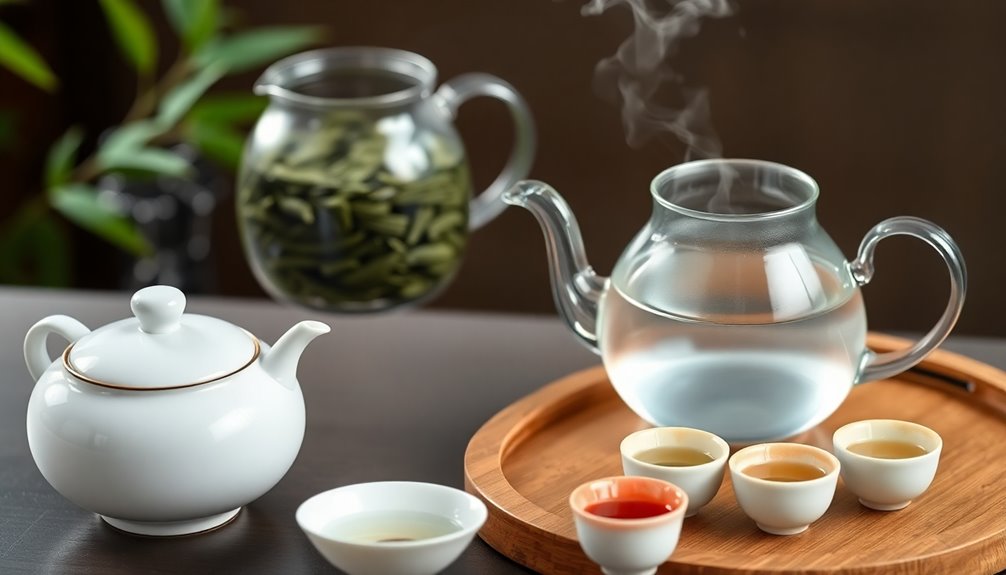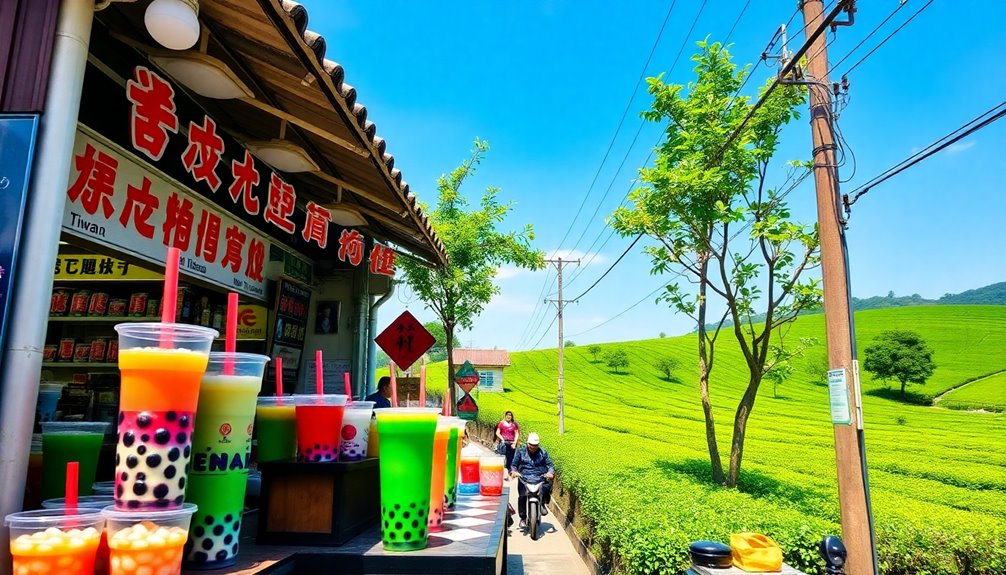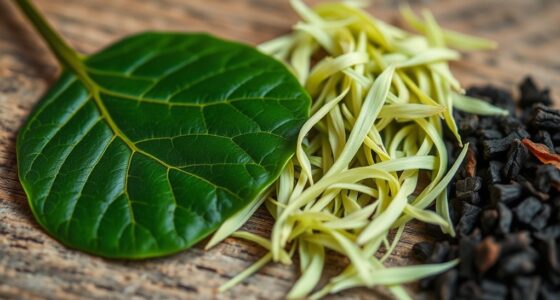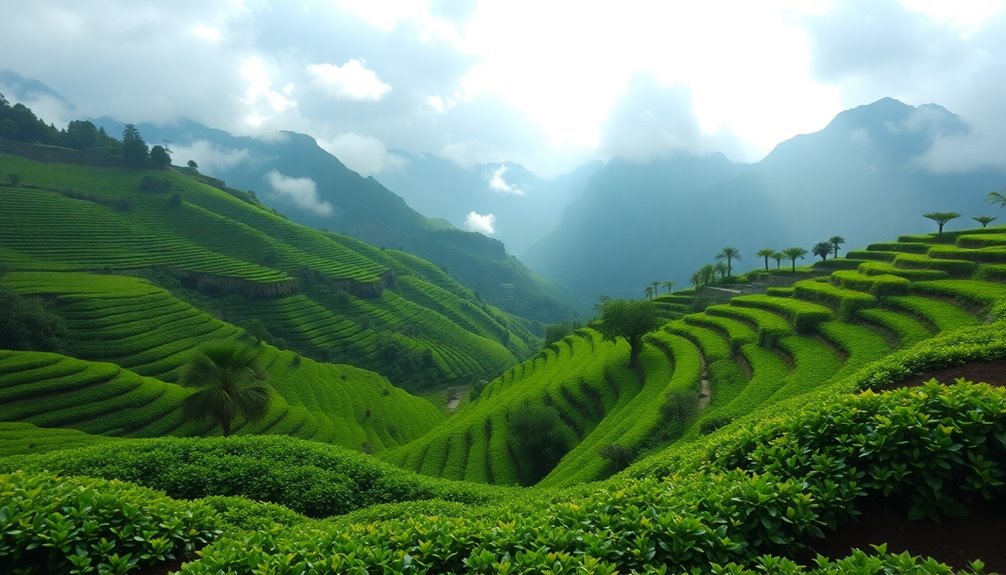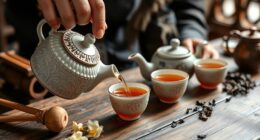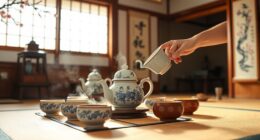Taiwanese tea is perfect for flavor experimentation because it's full of exciting and diverse tastes! You can explore a variety of flavors, such as:
- Floral notes in High Mountain Oolong
- Fruity hints in Oriental Beauty
- Creamy textures with GABA Oolong
You can also mix different teas and add herbal or fruit infusions for tasty blends. It's a fun way to share with family and friends too! Plus, floral aromas like jasmine make the experience delightful. So grab your favorite Taiwanese tea, and start creating your own special flavors. There's so much more to discover about this amazing tea!
Key Takeaways
- Taiwanese oolong teas offer diverse flavor profiles, including floral, fruity, and creamy notes, making them ideal for flavor experimentation.
- Traditional brewing methods like gongfu cha allow multiple infusions, enhancing the discovery of unique tasting experiences.
- The rich cultural practices surrounding Taiwanese tea encourage social gatherings and tasting sessions, fostering creativity in flavor experimentation.
- Modern innovations, such as fusion teas and infused blends with fruits and herbs, enhance the versatility of Taiwanese teas for creative brews.
- The growing global demand for organic teas drives innovation, providing more options for unique flavor combinations in Taiwanese tea.
Introduction
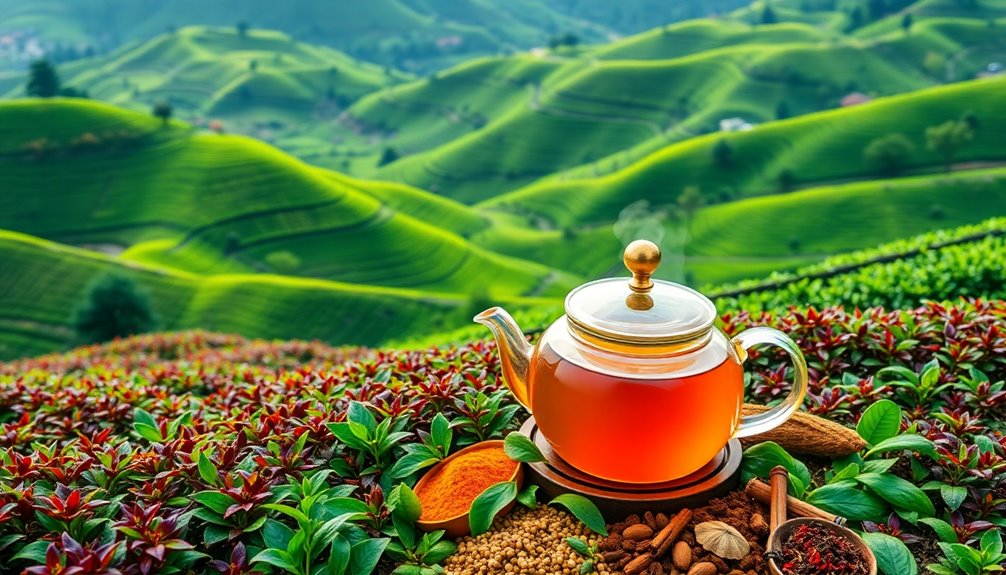
Taiwanese tea is a treasure trove of flavor, especially when it comes to oolong varieties that can surprise your palate with floral, creamy, or fruity notes.
You'll love exploring the unique characteristics of Taiwanese tea, as each sip reveals a new adventure. Oolong teas, in particular, shine with their diverse flavor profiles, making them perfect for experimentation.
Here are some fun facts that highlight their appeal:
- Traditional Brewing Methods: Try gongfu cha! This method encourages multiple infusions, allowing you to discover hidden flavors in each cup.
- High Mountain Teas: These teas grow in special climates, giving them distinct tastes that can't be found anywhere else.
- Cultural Events: Join communal tasting experiences in Taiwan, where you can share your thoughts and learn from others, creating a joyful atmosphere of tea culture.
- Unflavored Varieties: With options like Baozhong and high mountain oolong, you can enjoy the pure essence of tea without extra distractions.
- Health Benefits: Taiwanese tea, especially oolong, is rich in antioxidants that may help combat oxidative stress and promote overall wellness.
Tea's Diverse Flavor Profiles
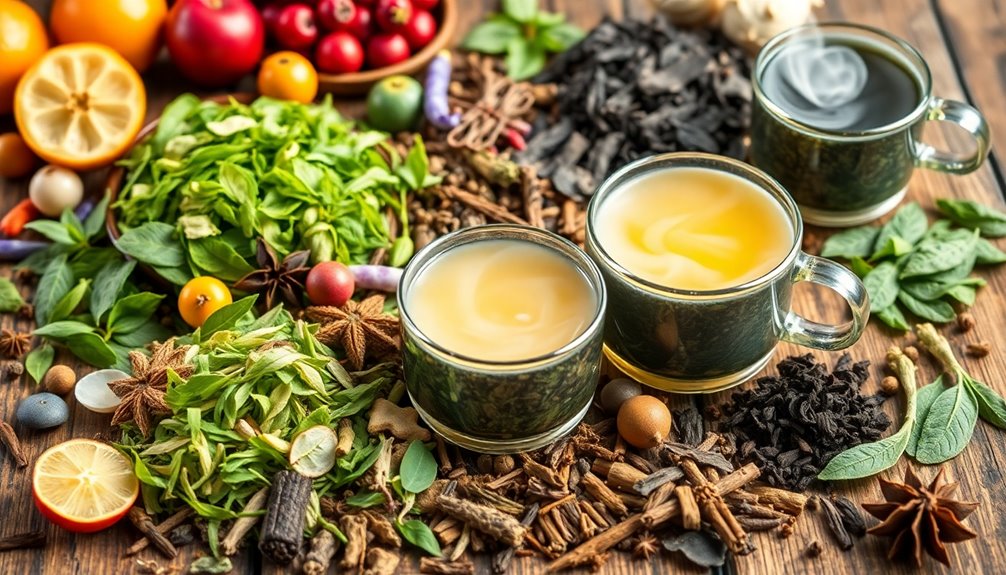
The world of Taiwanese oolong teas is a fascinating journey through diverse flavor profiles that captivate the senses. As a tea lover, you'll discover that each type of Taiwanese tea offers something special.
For instance, High Mountain Oolong delights with its floral notes, while the creamy textures of Dong Ding create a cozy experience.
- Oriental Beauty stands out with its honey, fruity, and malty notes, thanks to a unique processing method involving leafhoppers.
- GABA Oolong surprises you with its rich and smooth profile, featuring fruity undertones from a special anaerobic fermentation process.
- Ruby 18 combines fruity, malty, cherry, and menthol notes, showcasing the creativity of Taiwan's tea production by blending Assam tea and Camellia formosensis.
Taiwan's diverse growing conditions, from sunny slopes to misty mountains, contribute to these distinct flavor nuances. Moreover, the increasing global demand for organic tea pushes producers to innovate and enhance their flavor offerings.
Each sip reveals a new adventure, inviting you to explore and enjoy the depth of Taiwanese teas. With such an exciting variety, you'll always find a tea that sparks joy and curiosity.
Flavor Experimentation Opportunities Abound
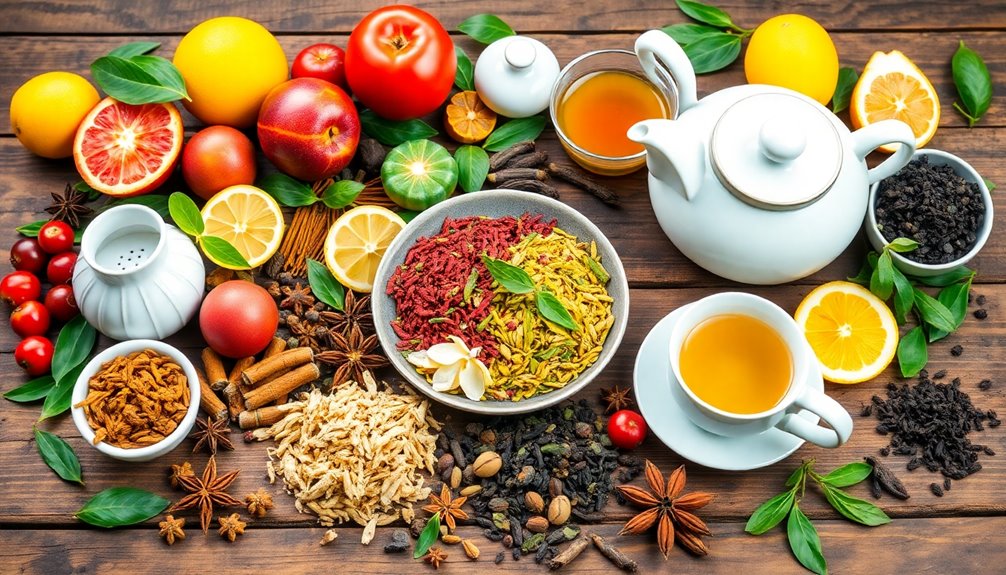
Exploring the diverse flavor profiles of Taiwanese teas opens up a world of experimentation that tea enthusiasts can't resist.
You'll find that oolong teas, like High Mountain Oolong and Oriental Beauty, boast a delightful mix of floral, fruity, creamy, and nutty flavors. This variety is perfect for creative experimentation! The nutritional benefits of chia seeds can also complement your tea experience by providing added health perks.
When you gather with friends for tasting sessions, you can discover unique combinations that make your taste buds dance.
Try blending unflavored Taiwanese tea with herbal or fruit infusions to create your special brews. It's a fun way to personalize your tea experience!
Plus, the trend of innovative tea cocktails is gaining popularity, bringing Taiwanese teas into the spotlight.
Imagine sipping on a refreshing tea cocktail that showcases the best of oolong's flavor profiles!
Here are some ways to enjoy Taiwanese tea experimentation:
- Host a tasting session with family and friends.
- Combine different tea types for exciting flavors.
- Experiment with tea cocktails that surprise your palate.
Additionally, consider using eco-friendly materials for any tea accessories you create, as this aligns with sustainable practices.
Each sip is a chance to explore. So, grab your favorite Taiwanese tea, and let your flavor adventure begin!
Floral Notes in Tea Blends
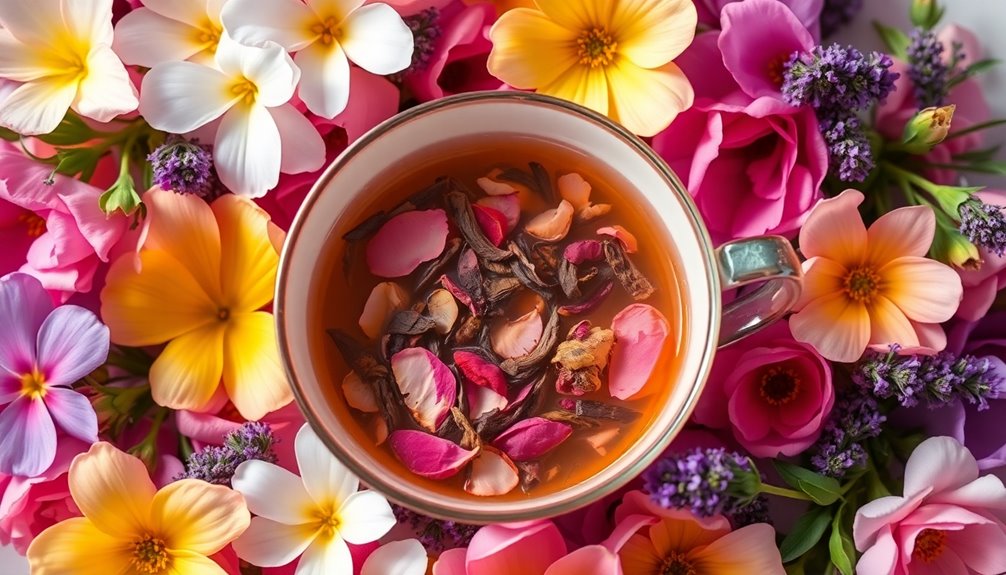
Capturing the essence of floral notes in tea blends can elevate your tasting experience to new heights. Taiwanese oolong teas, like High Mountain Oolong and Dong Ding, are known for their delightful floral aromas. These notes can range from light and delicate to rich and complex, making them fantastic for experimenting with different flavors.
You can enhance these floral notes by using flower petals such as osmanthus and jasmine. When blended with Taiwanese teas, these flowers create harmonious mixes that celebrate the tea's natural beauty. Imagine sipping a cup of oolong, where the sweet scent of osmanthus dances playfully with every sip!
Here are some tips for creating your own floral blends:
- Choose your base: Start with a Taiwanese oolong, like Baozhong or Oriental Beauty.
- Add flowers: Experiment with osmanthus or jasmine petals to bring out those lovely floral notes.
- Mix it up: Don't be afraid to combine different teas and flowers to discover unique flavor profiles.
Flavor Balance in Tea Blends
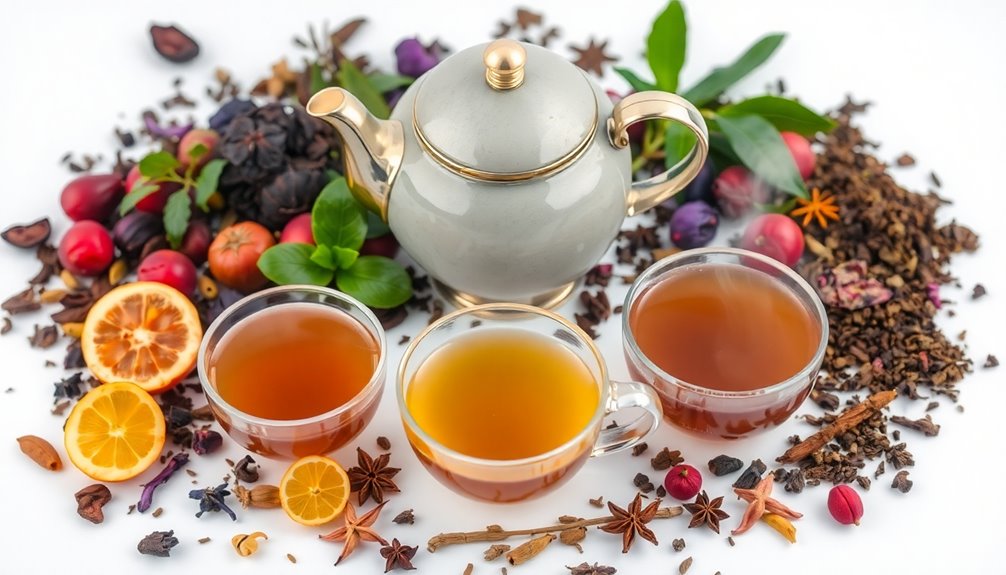
Achieving flavor balance in tea blends is essential for creating a truly enjoyable experience. When you blend Taiwanese teas, especially high mountain oolongs, you can create delightful flavor combinations.
Taiwanese tea farmers work hard to cultivate teas with unique terroir, showcasing floral and fruity notes that dance on your palate. The use of essential oils can also enhance the sensory experience of tea, adding layers of aroma and flavor.
Start with unflavored options like Baozhong or high mountain oolongs, which provide a pure base for your blends. This way, you can add fruits or herbs without masking the tea's essence.
The processing techniques used by farmers enhance the tea's natural sweetness and aromatic qualities, making each sip a joyful adventure.
Engaging in tasting sessions can be fun! Invite friends or family and explore different tea blends together.
You'll learn how flavors interact, helping you refine your palate. Experimenting with various ingredients can lead to exciting discoveries, from calming chamomile to zesty citrus. Including nutritional support in your blends can also enhance the overall experience, as certain ingredients may contribute to improved well-being.
Practical Applications
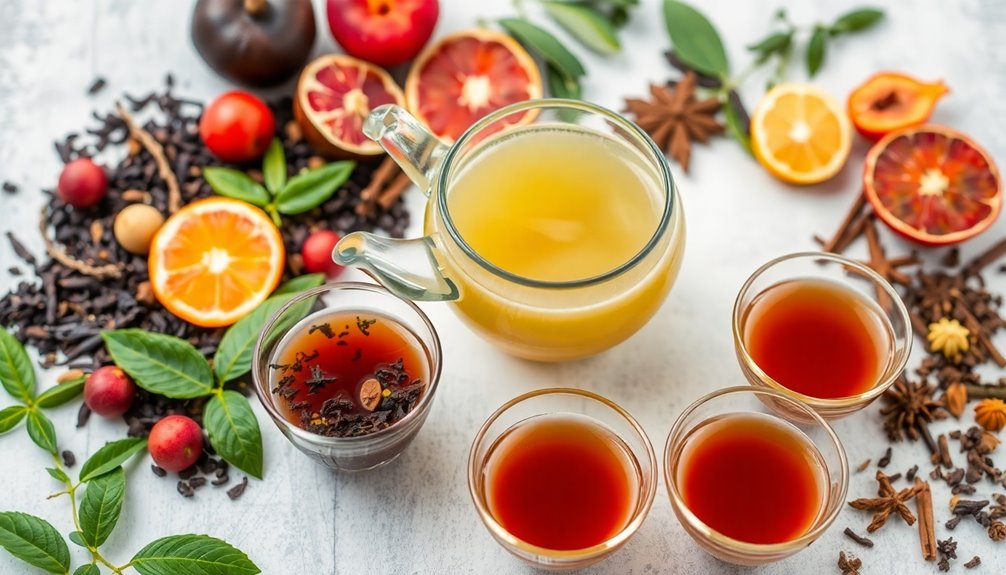
Practical applications of Taiwanese tea experimentation can transform your brewing experience into a delightful exploration of flavors. You can start by trying different Taiwanese oolong varieties, each with unique flavor profiles, from floral and fruity to creamy and nutty.
Explore various brewing techniques like gongfu cha, which allows for multiple infusions. Each steeping reveals new tastes, making every cup a little adventure!
If you love mixing things up, consider using Oriental Beauty in creative cocktail recipes. Its honey and fruity notes shine when paired with other ingredients, making your drinks extra special.
Don't forget about GABA oolong! Its rich and smooth taste not only delights your palate but also offers health benefits. Moderation is advised for optimal health benefits while enjoying your tea.
Join friends and family for tea tasting sessions at local tea shops or community events. You might discover unexpected flavor combinations that everyone will enjoy.
Remember, tea isn't just a drink; it's a fun way to bond and celebrate together. So grab your teapot, gather your loved ones, and dive into the wonderful world of Taiwanese tea.
With each sip, you're sure to find joy and excitement in your flavor exploration!
Frequently Asked Questions
What Type of Tea Is Taiwan Known For?
Taiwan's primarily known for its diverse range of oolong teas, especially high mountain varieties, which offer complex flavors. You'll also find exceptional Oriental Beauty and rich black teas, all showcasing unique characteristics and taste profiles.
Why Is Tea Important in Taiwan?
Tea's important in Taiwan because it reflects cultural heritage and social practices. You'll find it at gatherings and rituals, and children learn its appreciation early, ensuring it remains a cherished part of daily life.
Which Country Has Most Tasty Tea?
When you think about the tastiest tea, many would argue that Taiwan stands out. Its unique oolong varieties offer complex flavors that captivate your palate, making it a top choice for any tea lover's collection.
How Do You Get the Most Flavour Out of Tea?
To get the most flavor out of tea, use high-quality leaves, adjust water temperature for each type, experiment with steeping times, and try different brewing vessels to find your perfect balance and unique taste.
Conclusion
Taiwanese tea is a fantastic choice for exploring new flavors! With its rich floral notes and unique blends, you can mix and match to create your own delightful drinks. Whether you're hosting a family tea party or just enjoying a quiet moment, experimenting with different flavors can be a fun adventure. So grab your favorite Taiwanese tea, get creative, and let your taste buds dance with joy! Cheers to new flavors and happy memories together!

